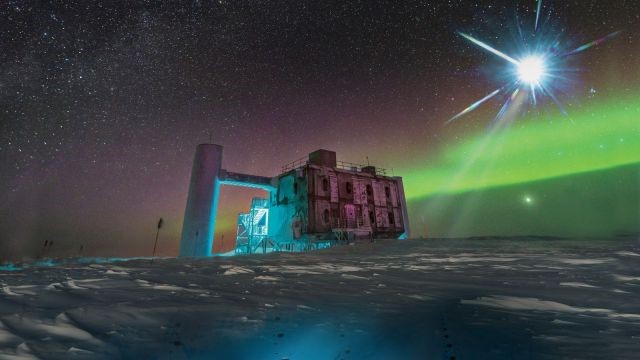Description

Disclaimer: Copyright infringement not intended.
Context
Astronomers detect seven potential ‘ghost particles’ that passed through planet.
Details
- Recent findings from the IceCube Neutrino Observatory in Antarctica have provided potential evidence for astrophysical tau neutrinos, marking a significant milestone in our quest to understand the universe's most elusive messengers.
- Researchers at the IceCube Observatory have reported the detection of seven potential tau neutrino events in data collected between 2011 and 2020.
- Utilizing convolutional neural networks (CNNs) trained for image classification, scientists distinguished between images produced by tau neutrinos and those from background processes.
Significance of Discovery
- The discovery of astrophysical tau neutrinos provides crucial confirmation of IceCube's earlier detection of the diffuse astrophysical neutrino flux.
- It offers insights into the most energetic phenomena in the cosmos, originating from the farthest reaches of the universe.
- Tau neutrinos, being the rarest of neutrino flavors, offer unique information about astrophysical sources and particle interactions at extreme energies.
- Understanding the properties and origins of astrophysical neutrinos enhances our knowledge of cosmic accelerators, such as active galactic nuclei and gamma-ray bursts.
- Tau neutrinos serve as cosmic messengers, carrying information about cataclysmic events and cosmic ray interactions, shedding light on the universe's high-energy processes.
About the IceCube Neutrino Observatory
- The IceCube Neutrino Observatory, nestled within the vast expanse of Antarctic ice, stands as a beacon of scientific inquiry into the mysteries of the universe.
Overview:
- IceCube, completed on December 18, 2010, comprises thousands of spherical optical sensors, known as Digital Optical Modules (DOMs), distributed over a cubic kilometer beneath the Antarctic ice.
- DOMs, equipped with photomultiplier tubes (PMTs) and data acquisition computers, are deployed on strings at depths ranging from 1,450 to 2,450 meters using hot water drills.
- The observatory, designed to detect teraelectronvolt (TeV) range neutrinos, aims to explore the highest-energy astrophysical processes, seeking point sources of these elusive particles.
Collaboration and Funding:
- Supervised by the University of Wisconsin–Madison, IceCube is a collaborative effort involving numerous universities and research institutions worldwide.
- Construction, facilitated by Antarctic austral summers, began in 2005, with gradual deployment of strings over successive seasons, culminating in its completion in 2010.
Sub-Detectors:
- AMANDA: The Antarctic Muon And Neutrino Detector Array, serving as a precursor to IceCube, provided proof-of-concept for the observatory's design and functionality.
- IceTop Array: Positioned on the glacier's surface above each IceCube string, IceTop functions as a cosmic ray shower detector, complementing IceCube's neutrino observations.
- Deep Core Low-Energy Extension: Situated at the center of the array, Deep Core extends the observable energy range below 100 GeV, enhancing sensitivity to low-energy neutrinos.
- PINGU (Precision IceCube Next Generation Upgrade): A proposed extension, PINGU aims to detect low-energy neutrinos, enabling precise measurements of neutrino properties and searches for dark matter interactions.
- Plans for IceCube2, pending federal approval, envision detectors eight times larger than current ones, enhancing sensitivity and expanding the observatory's capabilities.

About Neutrinos
- Neutrinos, often referred to as "ghost particles," are elusive subatomic particles that interact weakly with matter.
- They belong to the lepton family, along with electrons and muons, but unlike their charged counterparts, neutrinos are electrically neutral.
- First postulated by Wolfgang Pauli in 1930, neutrinos were confirmed experimentally in 1956, opening up a new frontier in particle physics.
Properties of Neutrinos:
- Electrically Neutral: Neutrinos do not carry any electric charge, which allows them to traverse matter without electromagnetic interactions.
- Tiny Mass: While initially thought to be massless, neutrinos have been proven to have extremely small but non-zero masses, as indicated by oscillation experiments.
- Spin ½: Neutrinos are fermions with a half-integer spin, obeying the rules of quantum mechanics.
- Weak Interaction: Neutrinos primarily interact via the weak nuclear force, making them challenging to detect due to their feeble interactions with matter.
Types of Neutrinos:
- Electron Neutrinos (νe): Associated with electron interactions, such as those occurring in beta decay processes.
- Muon Neutrinos (νμ): Correlated with muon interactions, commonly produced in cosmic-ray showers and particle accelerators.
- Tau Neutrinos (ντ): Linked to tau interactions, which are heavier counterparts of electrons and muons, typically found in high-energy astrophysical events.
Neutrino Oscillations:
- Neutrino oscillation phenomenon, elucidated by pioneering experiments like the Super-Kamiokande and Sudbury Neutrino Observatory (SNO), demonstrates that neutrinos can change flavors as they propagate through space.
- Oscillations imply that neutrinos have non-zero masses and can mix between different flavor states (electron, muon, and tau neutrinos) over time.
Neutrinos in Astrophysics:
- Solar Neutrinos: Neutrinos produced in nuclear fusion reactions within the Sun serve as crucial probes for understanding stellar processes and solar composition.
- Supernova Neutrinos: Neutrinos emitted during core-collapse supernovae provide vital insights into the explosion mechanism and nucleosynthesis in stellar interiors.
- Cosmic Neutrinos: High-energy neutrinos originating from astrophysical sources, such as active galactic nuclei, gamma-ray bursts, and cosmic-ray interactions, offer a window into the universe's most energetic phenomena.

Neutrino Detection Techniques:
- Cherenkov Radiation: Neutrino interactions in water or ice can produce Cherenkov radiation, detectable by instruments like the Super-Kamiokande detector.
- Scintillation Detectors: Neutrinos interacting with certain materials, such as liquid scintillator, emit light signals that can be detected by photomultiplier tubes.
- Radio Detection: Ultra-high-energy neutrinos interacting with Antarctic ice can generate radio waves, which are picked up by antennas in experiments like IceCube.
Open Questions:
- Despite significant progress, several questions regarding neutrinos remain unanswered, including the absolute neutrino mass scale, the nature of neutrino mass generation mechanisms, and the prevalence of CP violation in neutrino oscillations.
- Future experiments, such as the Deep Underground Neutrino Experiment (DUNE), Hyper-Kamiokande, and PINGU/IceCube-Gen2, aim to address these fundamental questions and unlock new insights into the nature of neutrinos and their role in the cosmos.
|
PRACTICE QUESTION
Q. Tau neutrinos serve as cosmic messengers, carrying information about cataclysmic events and cosmic ray interactions. Comment. (250 Words)
|














